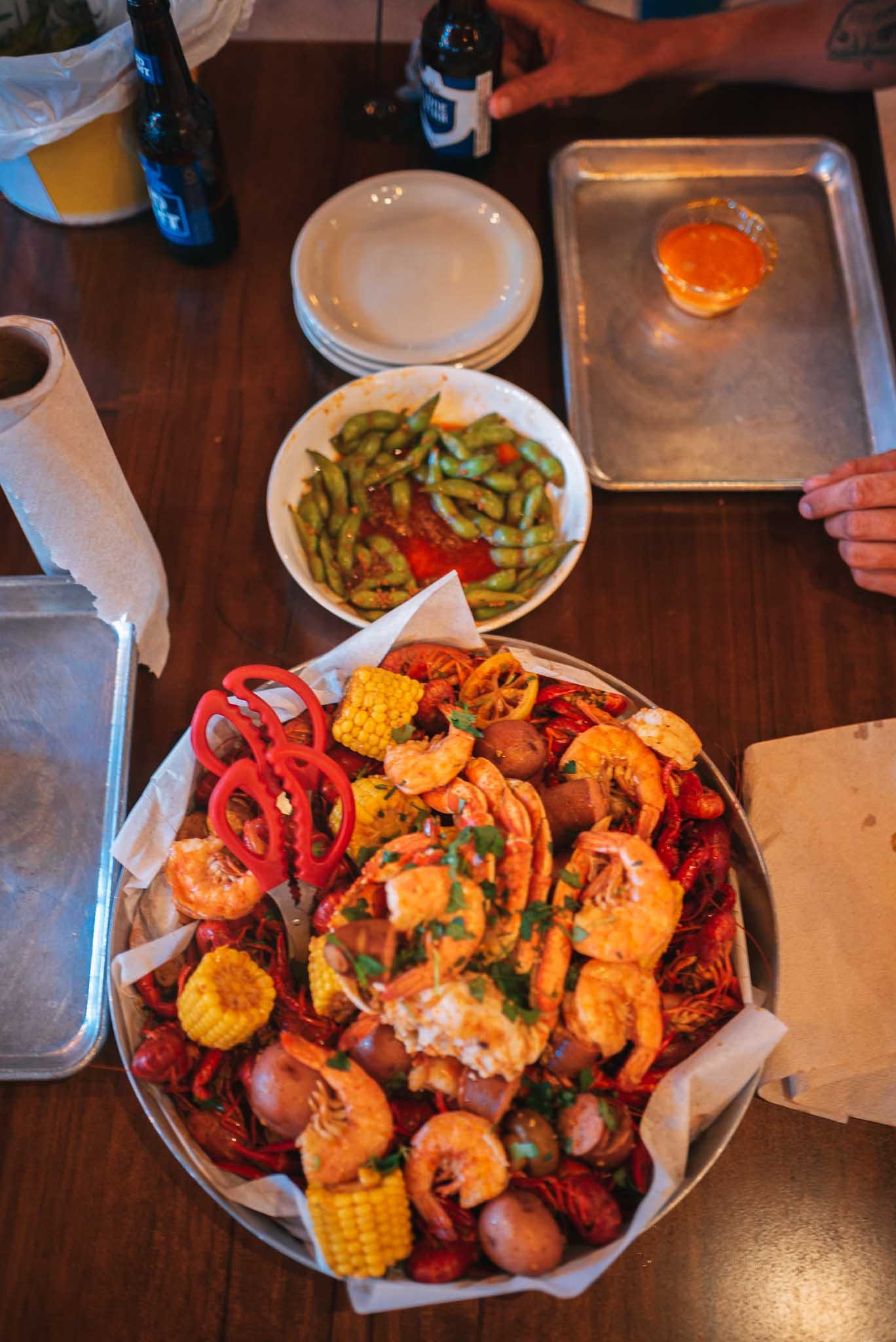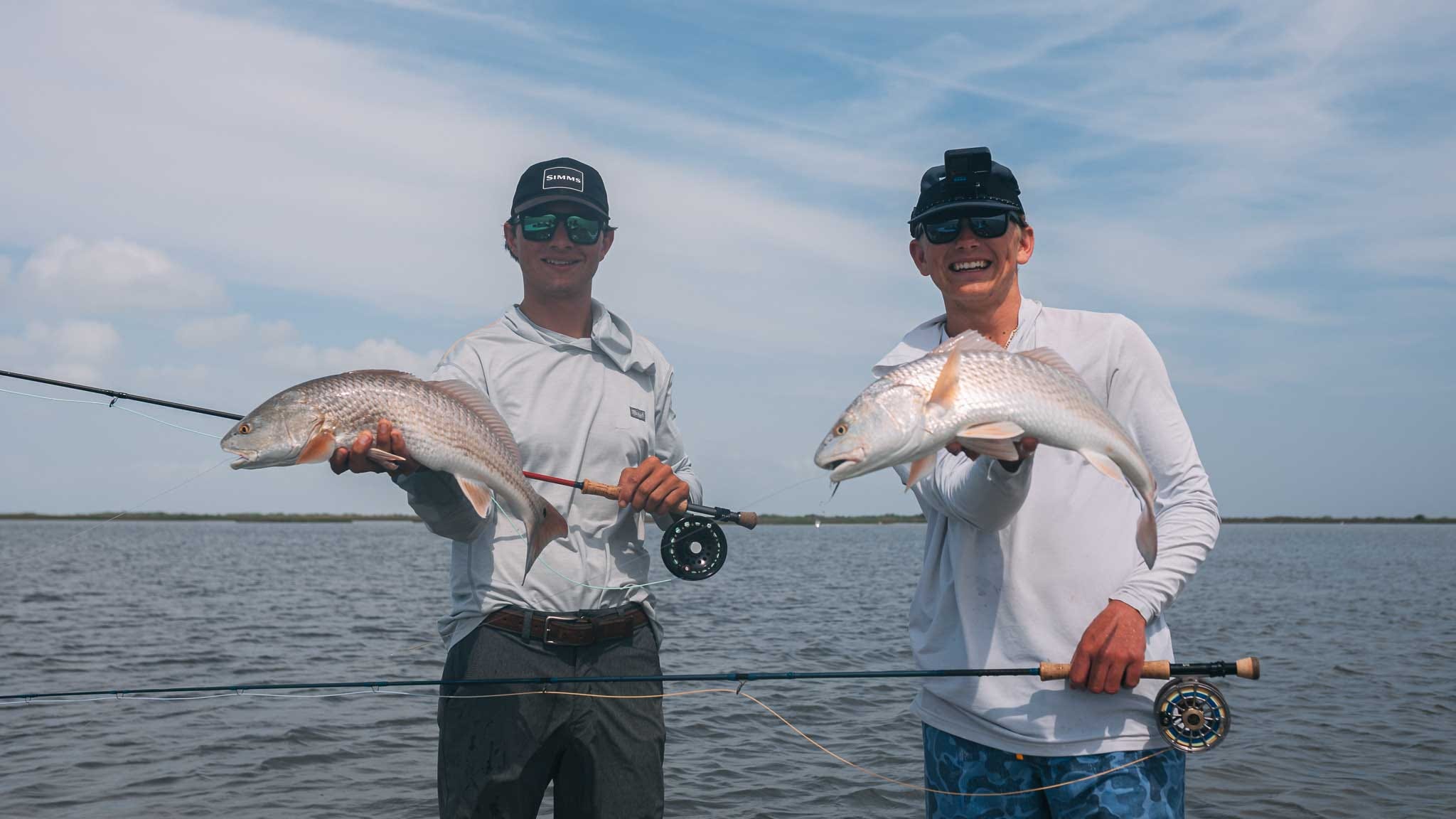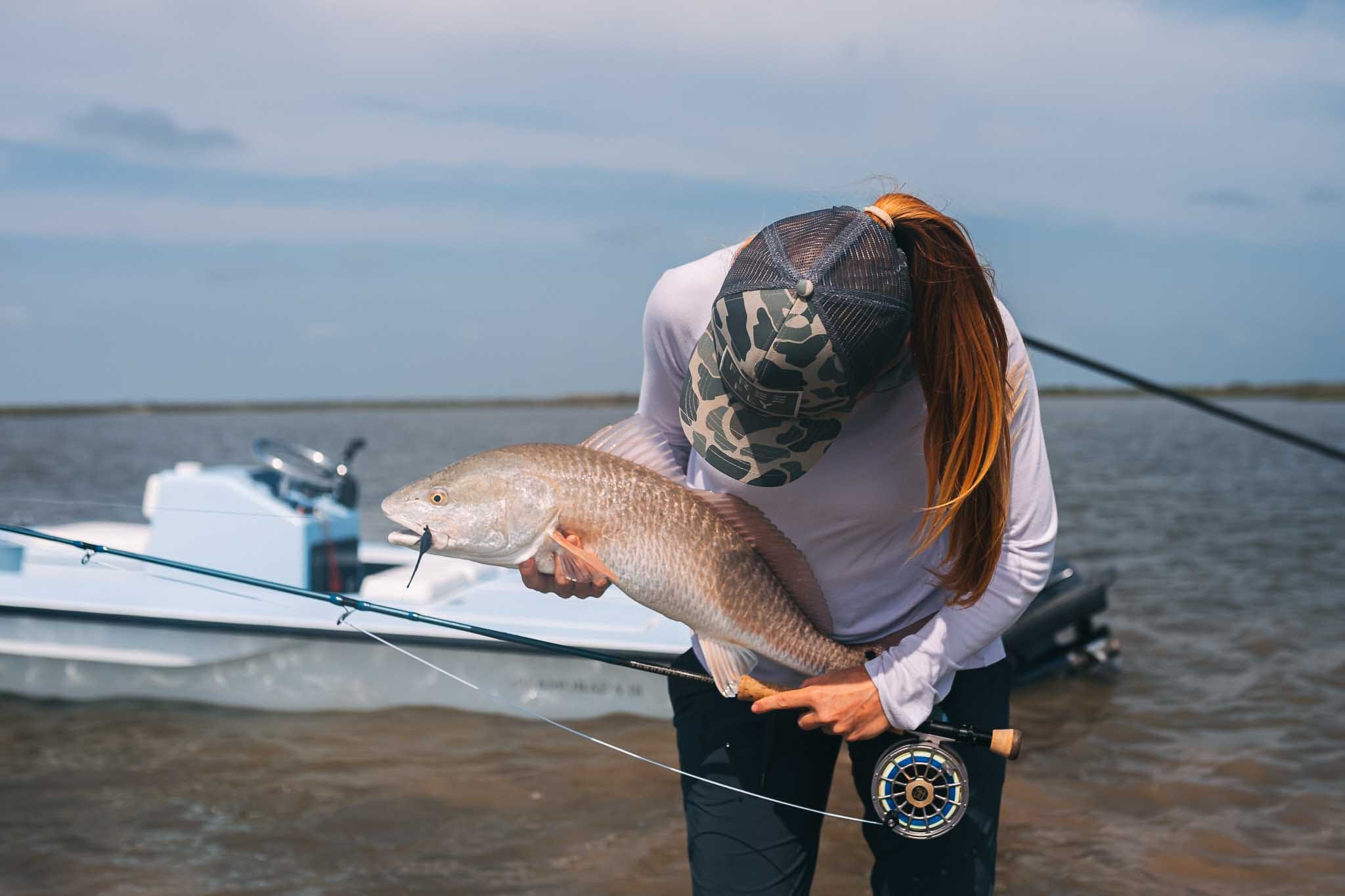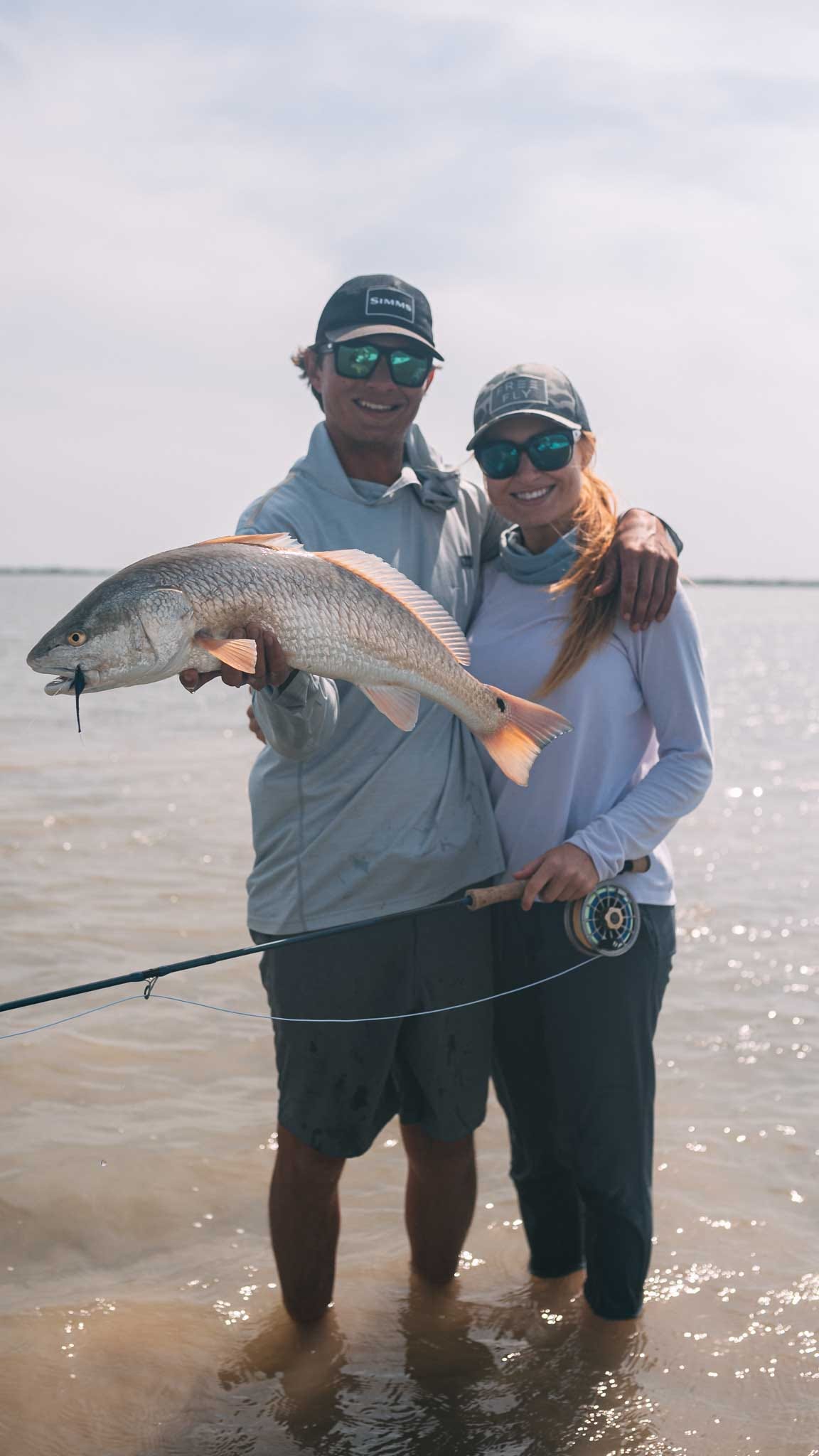IDAHO X TEXAS REDFISH – A First Timer’s Account in the Lone Star State

"The fly practically landed in this fish’s mouth and absolutely demolished it before Mason could even strip his fly."
I was an intern at No Name Fly Lodge in Puerto Rico, and it was there I had the pleasure of meeting Mason Matejcek when he came down to help model a new clothing line In Puerto Rico. We all called him Mason, but when I got invited to fish with him in Texas he became Captain Mason.
Captain Mason was born and raised on the Texas Coast. He began guiding for Redfish in Texas at age 18, and he is now 25 at the time this article was written. He is also a full-time Texas Gulf Coast redfish and waterfowl guide. Mason invited me to Texas, and although I’m not sure why or how I deserved the opportunity, I was stoked and I said, “Heck yes.” So, I bought a plane ticket with the goal of a) catching some redfish b) spending some time with Mason, and c) getting to experience the south Texas Gulf Coast culture.


I had no expectations in terms of catching a redfish, I knew how challenging catching a redfish on a fly can be. This is the mindset I always try to take going into any new saltwater fly fishing experience. So many things must go right for it all to come together. The sun must cooperate so you can see the fish, the wind can make it difficult to cast, and the fish must be happy. Furthermore, I must drop a dime in the diameter of a dinner plate to not spook the fish but still get it close enough that the fish sees the fly, and you don’t want the redfish to see the fly land.
Also, I’m from Idaho. I have been lucky enough to fish saltwater a handful of times, but it’s still not what I do day to day in Idaho where I’m either fishing or guiding others to trout.
I landed late the first night from Idaho, and immediately hit the hay after hyping ourselves up in the living room on the tv watching re-runs of “Jeopardy.” It was a hoot.


The first morning started at 8 AM, and it was the first time seeing the light of day as we arrived in the dark the previous night. My first thoughts were, “Texas is beautiful, humid, and green”. There were deer all over the front yard as we put a few items in the boat, and my dry Idaho skin was just absorbing the Texas humidity. Mason was dialed, his morning routine took 5 minutes. He hooked up the boat, grabbed rods, and we left. We stopped at the gas station right by his house and then hit the boat ramp nearby. In less than 30 minutes from the time I woke up we were moving full throttle through the marsh. Some of the first things that stood out to me were the birds everywhere and also these large tugs and barges transporting goods. It was a unique sight that we don’t see in Idaho.
After a 20-30 minute ride, Mason just turned into a grass canal channel and drove up the narrow creek like he had done it a thousand times. I remember thinking, “I would have had this boat beached running up a canal like that”. The first day was very cloudy and windy, not ideal conditions for sight-fishing redfish. Thankfully, Mason knew where to go and what to look for. When we didn’t have sun, it was a game of looking for tails or backs of reds. We had a slow morning until we rounded a corner and he told me to be ready, sure enough, we started getting into fish that were pushed up in the skinny water, and much more visible.
There was a tiny cove on my right at about 3 o’clock with a redfish sitting perfectly in the center of it. I made two fast false casts and laid a 10-foot backhand, a bit too far over the fish. Picked it up and dropped another one a bit more in that fish’s sight. Took one strip boat side and the fish tracked it, then crushed the fly. I had my 9-foot 9 wt Squatch 2, and it was perfect for accurate casts like I had to make on this first Texas red. I was quick to learn that one has to be deadly accurate from both close or far range when fly fishing for redfish. I’ve heard that in some areas these fish can be very spooky and of course, the larger they get, sometimes the more educated. It’s necessary to have trained eyesight to spot that fish through the water if it is not tailing, locate its head instead of its tail, and land it in a small radius.
ON THE BOARD
I got on the poling platform to try and get Mason on a fish, which was a bad decision. The wind was howling and I struggled to keep the boat moving slowly and positioned correctly. The Texas coast is known for persistent wind and it takes some serious practice and skill up there to be able to control the boat well. Just after my fish, another redfish about 100 yards ahead of us was doing the dirty all over a flat. This red was making noise, splashing, beaching itself with its back out of the water, and getting its face in the mud. I pushed fast to the fish while it was in a vulnerable spot to cast at. Mason made at least five casts right on this fish’s head and it didn’t make a single flinch. We were laughing under our breath in confusion because this big red just sat there like a beached whale as flies were all over his peripheral vision. It wasn’t until the wind finally threw the stern of the boat and forced Mason to make a final backcast before we drifted away. The fly practically landed in this fish’s mouth and absolutely demolished it before Mason could even strip his fly. It was one of the most exciting eats I’ve seen in saltwater fly fishing to date.
After getting off the water, we were hungry and Mason and I were already talking about grubbin’ down. Somehow, I had never experienced a crawfish boil and it wasn’t long until Mason provided me with my first experience. We hit a local restaurant in town and ordered a few pounds of shrimp, a few pounds of crawfish, and some edamame for an appetizer. That meal will forever be in my dreams. I'll go back to Texas for the crawfish boil alone just as urgently as to be fishing for badass reds.


DAY TWO
On day two Mason’s girlfriend Cierra joined us in the boat. We made a long run to a zone Mason seemed excited about. Right off the bat, we were into fish. Mason and Cierra were kind enough to give me the bow of the boat more than I deserved on this trip, and I was up first. I blew my first few shots by landing casts too close or too far away on the first few fish we saw.
It was Cierra’s turn to get up front and I took the push pole. We had a baby redfish crush the fly at her feet right away. Only a few moments later, unfortunately, the wind and clouds started rolling in and it kept us from being able to see more redfish before they saw the boat. Keep in mind, Mason’s Chittum was riding in INCHES of water, and the redfish would feed, swim, slide, and hide in inches of water unnoticed. It was so cool.
We decided to try one more spot in the late afternoon, Mason made another far run. We went into a shallow bay, having to push the boat through such shallow water we left a mud trail as we grazed the bottom, which is evidently normal in Texas. It took a strong push to get through the mud but it was worth the effort. Mason saw a waking fish and dropped a dime right in front of it. The fish ate, Mason’s rod got tight, and he brought in the biggest Texas redfish I’d seen so far on the trip. I got on the bow and saw another wake just after Mason released his, made the cast at it, and the fish ate. One thing I love about redfish is that they can be slightly more forgiving than some other flats fish. When we as anglers can do the right things, and the redfish are happy, then the redfish will eat the right way; most of the time. As I was reeling mine in, Mason had hopped off the boat and waded into the shallow mud as he spotted yet another fish. Only a moment later Mason had managed to hook it and we had our first “double” of the trip. I’m sure it was a ridiculous site to see, but no one was around, and we were pumped. We threw these fish in the box and decided to have them for dinner later. I had never eaten a redfish. We are usually catch-and-release anglers, but once in a while if we can make them fresh it is worth it to keep a few to eat; gotta eat something.


Now Cierra was on deck and we continued to look for not so much tails or backs, but those similar wakes we’d seen on the previous fish. The fish in this big bay were just slowly moving with the tide, and when they did feed, that’s when they’d show themself.
A big V pushed out from the left and we watched it closely for a while. For me, it is very difficult using the “nervous water” spotting method as there are mullet everywhere. I mean, EVERYWHERE. All the suspense ended when the fish’s tail stuck straight up like in a movie from F3T. Mason yelled, “Get out there Cierra, go get 'em!” She quietly waded toward the fish and the wind began to pick up, it would be a tough cast. Cierra struggled with her first two casts and the fly landed just behind and short of the fish. She picked up her line the third time, and fully loaded her rod, giving the fly a far lead on this big red moving in the skinny water. She took a couple of fast strips to get the fly in the fish’s path and it crushed it as soon as she intercepted that fish’s face. It was a textbook performance on her end.




When we got home, Mason fired up the grill in the backyard, and it was a beautiful Texas evening. He fileted the 2 redfish we kept and seasoned them up, adding lemon, and then wrapped them in foil. Redfish are tasty. This is all the more reason to make sure we continue to work as anglers to improve and conserve the resource we have on the Texas Gulf Coast. It’s amazing to go to a place where there are so many redfish we don’t have to feel guilty about taking one home.
If you just planned, or if you plan to plan your first trip to the Texas Gulf Coast to fish for redfish this is a list of things you should expect.
- It will be windy so practice your cast in the wind with 3” flies on.
- Redfish can be hard to see. Seeing fish in the grass is not as easy as seeing them on white sand flats so bring copper and low-light lenses.
- A true Southern experience and I recommend a crawfish boil.
-
Redfish aren’t easy to catch. They may be generally more cooperative than a permit, but they aren’t always easy. However, there are a lot of
redfish to be had.
- The guides will be as excited as you to go catch redfish.
The moral of my redfish story; and in the words of fly fishing artist and traveler Jeff Currier, “If you want to fish a lot of places in your life,
all you have to do is when someone invites you to go fishing, just say yes.”


A special thanks to Mason Matejcek. If you’d like to go fish with Mason you can reach him…
@Captain_mason on IG
